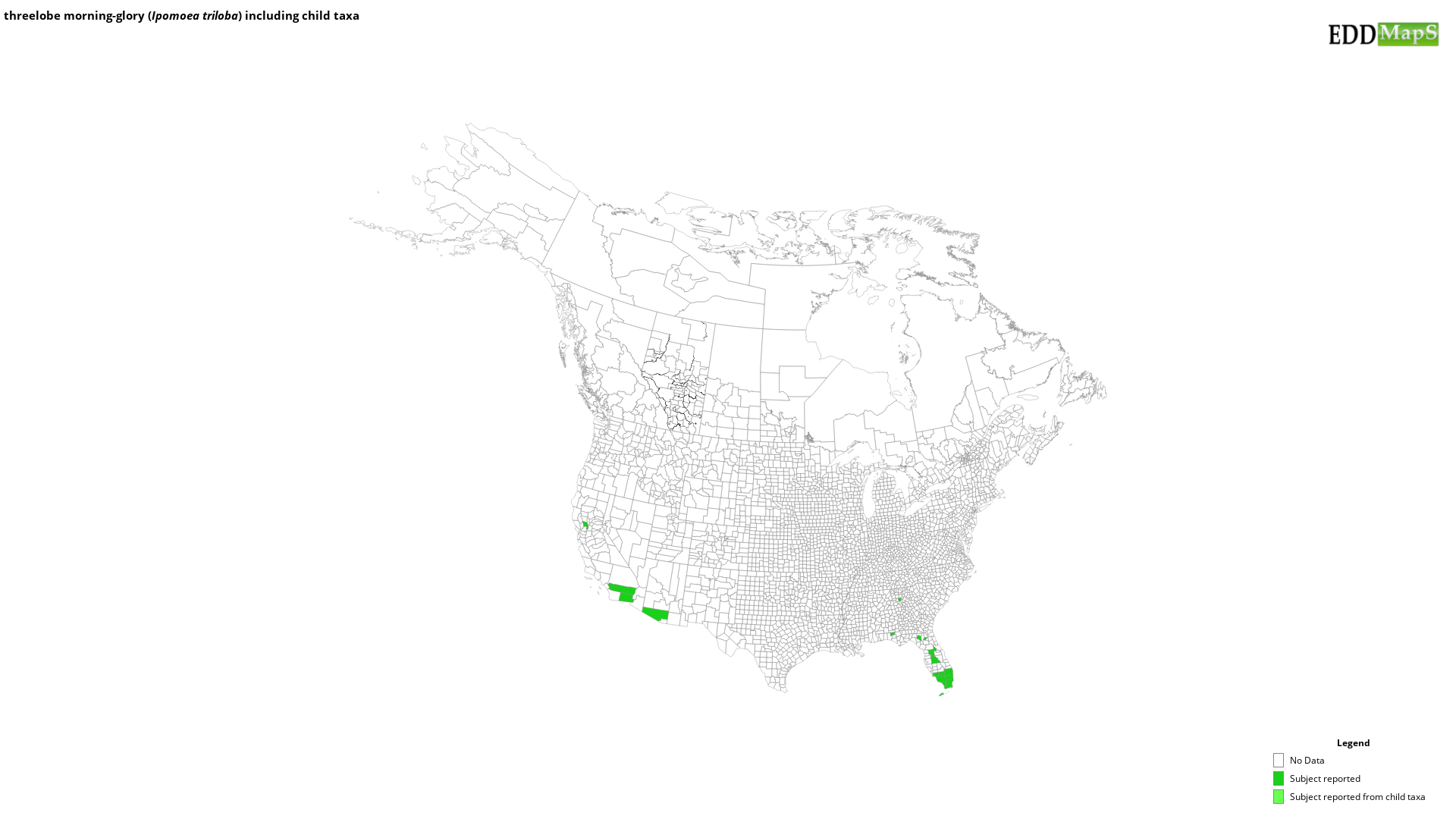threelobe morning-glory
(Ipomoea triloba)
This species is Introduced in the United States
ORIGIN: tropical South and Central America, Mexico, the Caribbean
GROWTH TRAITS: Herbaceous, an annual vine with stems growing up to 10’ (3 m) long from an extensive root system. Vines are rounded, slightly ridged, and highly twining so appear much shorter than they are; they do not climb much higher than grasses and low shrubs. Leaves are alternate, 0.8-5” (2-12 cm) long, and vary in shape from deeply 3-5 lobed to heart-shaped. Cut stems and leaf petioles exude a milky sap. Flowers appear in leaf axils throughout summer. Flowers are funnel-shaped with fused petals, 0.5-1” (1.2-2.5 cm) across, and vary in color from white to pink to pale purple with darker centers. They have 5 green, fringed sepals. Fruits are round, hairy, brown capsules containing 2-4 dark brown seeds.
REPRODUCTION: Spreads by seed. Seed longevity is unknown, but seeds of related Ipomoea species can remain viable for over 30 years.
HABITAT: Tolerates a wide variety of conditions in warm climates, including full sun to deep shade. It can be found in cultivated fields, grassy swamp margins, in hedgerows, along roadsides, and in waste places in sandy ground.
LOOK-ALIKES: The vining habit combined with white to purple funnel-shaped flowers help differentiate this species from unrelated look-alikes. Several native and exotic morning glory species occur in North America and can be distinguished by their differences in flower color, leaf shape, and root structures. The weedy field bindweed (Convolvulus arvensis) is a perennial with a rhizomatous root system and smaller, arrowhead-shaped leaves. Hedge bindweed (Calystegia sepium) is a similar native but typically weedy species that climb much higher on vegetation or structures (6.5-13’ or 2-4 m) compared to three-lobed morning glory. Hedge bindweed leaves are also narrower and much less lobed, appearing nearly triangular. The exotic sweet potato (Ipomoea batatas) has larger flowers (1.25-2.75” or 3-7 cm across) and sweet potato tuber roots.
CITATIONS:
Rawlins, K.A., R.L. Winston, C.T. Bargeron, D.J. Moorhead, and R. Carroll. 2018. New Invaders of the Southeast. USDA Forest Service, Forest Health Assessment and Applied Sciences Team, Morgantown, West Virginia. FHTET-2017-05. Retrieved from http://bugwoodcloud.org/resource/pdf/FHTET-2017-05_New%20Invaders_SE.pdf
Winston, R.L., Andreas, J.E., Milan, J., DesCamp, W., Randell, C.B., and M. Schwarzlander. 2014. New Invaders of the Southwest. United States Department of Agriculture, Forest Health Technology Enterprise Team. FHTET-2014-12. Retrieved from https://bugwoodcloud.org/resource/files/14767.pdf
GROWTH TRAITS: Herbaceous, an annual vine with stems growing up to 10’ (3 m) long from an extensive root system. Vines are rounded, slightly ridged, and highly twining so appear much shorter than they are; they do not climb much higher than grasses and low shrubs. Leaves are alternate, 0.8-5” (2-12 cm) long, and vary in shape from deeply 3-5 lobed to heart-shaped. Cut stems and leaf petioles exude a milky sap. Flowers appear in leaf axils throughout summer. Flowers are funnel-shaped with fused petals, 0.5-1” (1.2-2.5 cm) across, and vary in color from white to pink to pale purple with darker centers. They have 5 green, fringed sepals. Fruits are round, hairy, brown capsules containing 2-4 dark brown seeds.
REPRODUCTION: Spreads by seed. Seed longevity is unknown, but seeds of related Ipomoea species can remain viable for over 30 years.
HABITAT: Tolerates a wide variety of conditions in warm climates, including full sun to deep shade. It can be found in cultivated fields, grassy swamp margins, in hedgerows, along roadsides, and in waste places in sandy ground.
LOOK-ALIKES: The vining habit combined with white to purple funnel-shaped flowers help differentiate this species from unrelated look-alikes. Several native and exotic morning glory species occur in North America and can be distinguished by their differences in flower color, leaf shape, and root structures. The weedy field bindweed (Convolvulus arvensis) is a perennial with a rhizomatous root system and smaller, arrowhead-shaped leaves. Hedge bindweed (Calystegia sepium) is a similar native but typically weedy species that climb much higher on vegetation or structures (6.5-13’ or 2-4 m) compared to three-lobed morning glory. Hedge bindweed leaves are also narrower and much less lobed, appearing nearly triangular. The exotic sweet potato (Ipomoea batatas) has larger flowers (1.25-2.75” or 3-7 cm across) and sweet potato tuber roots.
CITATIONS:
Rawlins, K.A., R.L. Winston, C.T. Bargeron, D.J. Moorhead, and R. Carroll. 2018. New Invaders of the Southeast. USDA Forest Service, Forest Health Assessment and Applied Sciences Team, Morgantown, West Virginia. FHTET-2017-05. Retrieved from http://bugwoodcloud.org/resource/pdf/FHTET-2017-05_New%20Invaders_SE.pdf
Winston, R.L., Andreas, J.E., Milan, J., DesCamp, W., Randell, C.B., and M. Schwarzlander. 2014. New Invaders of the Southwest. United States Department of Agriculture, Forest Health Technology Enterprise Team. FHTET-2014-12. Retrieved from https://bugwoodcloud.org/resource/files/14767.pdf
Selected Images
Maps
EDDMapS Distribution - This map is incomplete and is based only on current site and county level reports made by experts, herbaria, and literature. For more information, visit www.eddmaps.org
State Lists - This map identifies those states that have this species on their invasive species list or law.
Invasive Listing Sources
Taxonomic Rank
| Domain: Eukarya |
| Kingdom: Plantae |
| Phylum: Magnoliophyta |
| Class: Magnoliopsida |
| Superorder: Asteranae |
| Order: Solanales |
| Family: Convolvulaceae |
| Genus: Ipomoea |
| Ipomoea triloba |
References
Common Name Reference: Weed Science Society of America Common Names List
Scientific Name Reference: USDA, NRCS. 2010. The PLANTS Database. National Plant Data Center, Baton Rouge, LA, USA.


